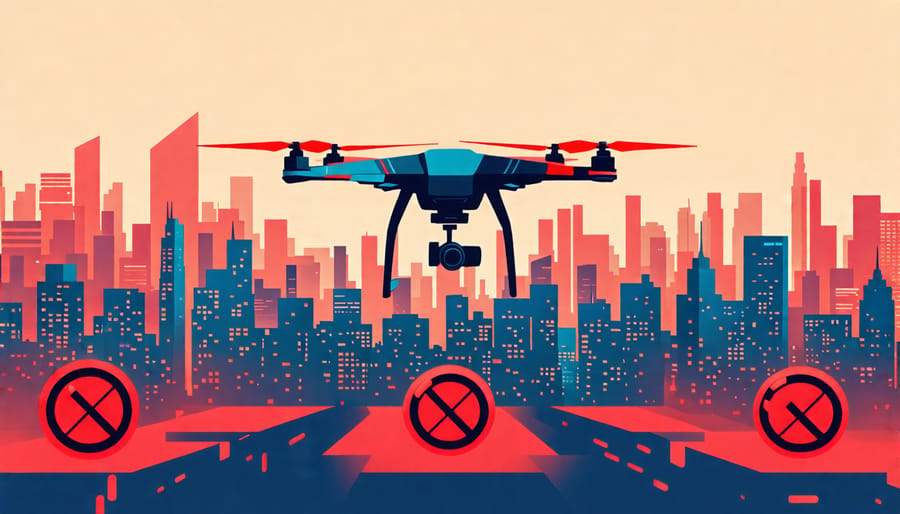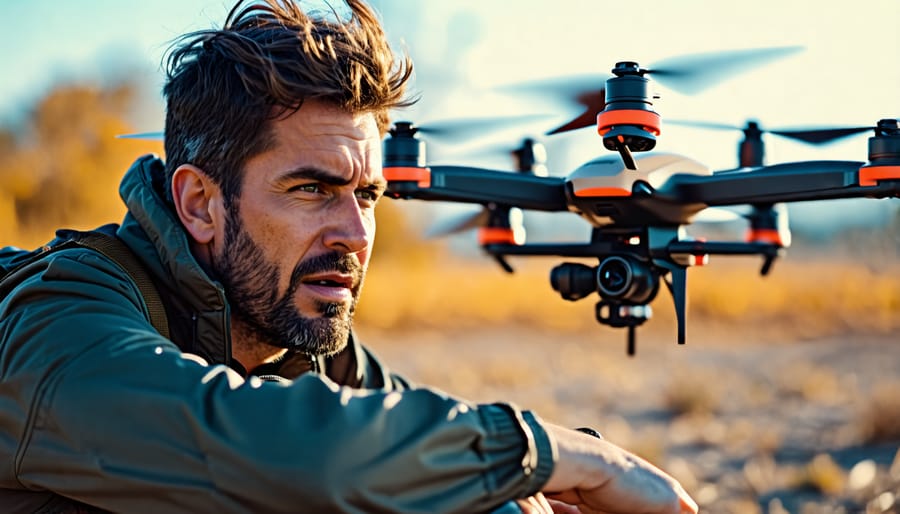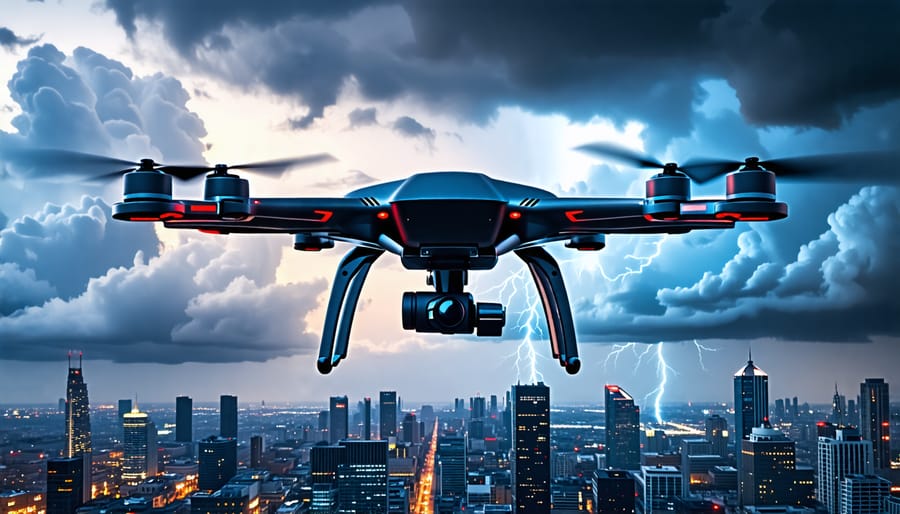Understand the rapid rise of drones and their transformative potential across industries, from assessing the global change with drones to revolutionizing delivery logistics. Yet this nascent technology faces complex challenges that threaten to constrain its growth and impact. Regulatory uncertainty, safety concerns, technological limitations, social resistance, and lacking infrastructure pose formidable obstacles. As drones take flight into an uncharted future, bold innovation and collaborative problem-solving will be essential to overcome these hurdles and unlock the full promise of unmanned aerial vehicles. The path forward is laden with risk and opportunity, and the stakes for business, society and the planet could not be higher. In this fast-evolving landscape, stakeholders must navigate with visionary leadership to shape a future where drones soar to new heights responsibly and beneficially.

Regulatory Hurdles
Case Study: Regulatory Roadblocks
In 2019, Virginia-based drone delivery company Wing faced significant regulatory hurdles as it sought to expand its operations. Despite having conducted over 80,000 successful test flights in Australia, Wing encountered resistance from the Federal Aviation Administration (FAA) in the United States. The FAA expressed concerns about the safety of Wing’s autonomous drones flying over populated areas and required the company to obtain special waivers for each proposed delivery route. This arduous process slowed Wing’s growth and highlighted the challenges drone companies face in navigating complex and evolving regulations. Wing persevered, working closely with the FAA to address safety concerns and demonstrate the reliability of its technology. Through open communication and collaboration, Wing ultimately secured the necessary approvals to launch its drone delivery service in select U.S. markets. This case study underscores the importance of proactive engagement with regulators and the need for drone companies to remain adaptable in the face of regulatory roadblocks. As the drone industry continues to expand, finding ways to work within existing regulatory frameworks while advocating for streamlined and standardized rules will be crucial to unlocking the full potential of drone technology.
Safety and Security Issues
As drones become more prevalent in our skies, safety and security concerns are growing. While most drone operators fly responsibly, the potential for accidents or misuse is real. Collisions with manned aircraft, power lines, or crowds could have devastating consequences. In 2018, a drone collided with a passenger plane in Mexico, raising alarm bells across the aviation industry.
System failures pose another risk. Drones rely on complex electronics and software that can malfunction due to manufacturing defects, environmental factors, or human error. A drone falling from the sky due to a system failure could cause injury or property damage.
Cybersecurity vulnerabilities are also a concern. Hackers could potentially hijack drones for nefarious purposes such as surveillance, smuggling, or even weaponization. In 2019, the U.S. Department of Homeland Security warned that Chinese-made drones could be sending sensitive data to their manufacturers, highlighting the need for better cybersecurity measures.
To mitigate these risks, the drone industry is working on technological solutions. Geo-fencing software can prevent drones from flying in restricted areas such as airports or crowded events. Collision avoidance systems use sensors to detect and avoid obstacles. Failsafe mechanisms can initiate controlled landings or returns to base in case of malfunctions.
Regulatory bodies are also stepping up efforts to promote drone safety. The FAA requires registration of drones over a certain weight and has issued guidelines for safe operation. Other countries have similar regulations in place.
Education and training are key to reducing risks. Many incidents are caused by inexperienced or reckless operators. Mandatory training and licensing could help ensure that all drone pilots understand and follow safety protocols.
As drone technology continues to advance, ongoing collaboration between manufacturers, regulators, and users will be essential to address evolving safety and security challenges. With responsible development and use, drones have the potential to revolutionize industries and improve lives – but only if we prioritize safety and security every step of the way.


Technological Limitations
Despite significant advancements in drone technology, several limitations still hinder their widespread adoption and viability across various sectors. One of the most pressing challenges is battery life. Current lithium-ion batteries powering most drones have a limited flight time, typically ranging from 20 to 30 minutes. This restricts the range and duration of missions, making drones unsuitable for long-distance deliveries, extended surveillance, or large-scale agricultural monitoring.
Range is another technological constraint. Most consumer and commercial drones rely on radio frequency communication between the controller and the aircraft. This limits their operational range to a few kilometers, as signals can be interrupted by physical obstacles or electromagnetic interference. While some drones use satellite communication for extended range, this technology is expensive and not yet widely available.
Payload capacity is a third limiting factor. The weight a drone can carry is determined by its size, motor power, and battery capacity. Smaller drones, which are more affordable and easier to operate, have limited payload capacity, often less than 5 kg. This restricts their use in delivery services, as they cannot transport heavier packages. Larger drones with higher payload capacities are more expensive, require specialized training, and are subject to stricter regulations.
These technological limitations have significant implications for the economic viability of drones in certain sectors. Limited flight times and ranges make it difficult to scale drone operations, as multiple batteries and frequent charging are required. The constraints on payload capacity also reduce the efficiency and profitability of drone-based delivery services, as they cannot compete with the volume of traditional ground transportation.
However, researchers and companies are actively working on solutions to overcome these limitations. Advances in battery technology, such as hydrogen fuel cells and solid-state batteries, promise longer flight times. The development of 5G networks and improved satellite communication could extend the range of drone operations. Lightweight materials and more efficient motors may increase payload capacities without compromising flight performance. As these technologies mature, they will unlock new possibilities for drone applications and enhance their economic viability across various industries.
Public Perception Problems
Despite the many beneficial applications of drones, negative public perceptions surrounding their use persist. Privacy concerns are a primary driver of this skepticism, with many individuals feeling uneasy about the potential for drones to conduct unauthorized surveillance or capture images without consent. The distinctive buzzing noise generated by drone propellers also contributes to unfavorable opinions, as people worry about drones causing disruptive noise pollution, particularly in residential areas.
Safety fears further compound public apprehension, especially in light of occasional reports of drones malfunctioning or crashing. Anxieties over drones potentially colliding with aircraft, damaging property, or injuring bystanders can overshadow their positive contributions. Building social acceptance of drones will require a multi-faceted approach centered on public education and constructive industry engagement.
Drone manufacturers and operators must prioritize transparency, openly addressing the public’s concerns and demonstrating a commitment to responsible drone use. Educational campaigns showcasing the strict regulations governing drone operations and the advanced safety features built into modern drones can help alleviate misconceptions. Highlighting real-world examples of drones’ beneficial applications, such as search and rescue missions or environmental conservation efforts, can further foster a more balanced public perspective.
Proactive community outreach by the drone industry is essential for cultivating trust and understanding. Regularly engaging with local communities through informational workshops, Q&A sessions, and live demonstrations can provide opportunities for the public to learn about drone technology firsthand and voice their concerns directly to experts. By listening to and addressing these apprehensions head-on, the drone industry can work collaboratively with the public to find mutually agreeable solutions and pave the way for greater social acceptance of this transformative technology.
Infrastructure Inadequacies
Despite the rapid growth of the drone industry, the current infrastructure in most areas is inadequate to support widescale drone deployment. Existing air traffic management systems are designed for manned aircraft and lack the capabilities to safely integrate large numbers of autonomous drones. Designated airspace for drone operations is limited, leading to potential conflicts with traditional aviation and concerns over privacy and security in residential areas.
Another critical infrastructure gap is the lack of landing and charging stations for drones. As battery technology improves, drones are capable of longer flights, but they still require safe spaces to land and recharge. This is particularly important for delivery drones and other commercial applications that need to operate over extended periods.
Recognizing these challenges, several initiatives aim to develop drone-friendly infrastructure. NASA, in collaboration with the FAA and industry partners, is developing an Unmanned Traffic Management (UTM) system to safely coordinate drone flights alongside manned aircraft. Cities and municipalities are also exploring the creation of dedicated drone corridors and landing hubs to support local drone operations.
Overcoming infrastructure inadequacies will be crucial to realizing the full potential of drones for environmental monitoring, renewable energy inspections, and sustainable transportation. By proactively investing in UTM systems, designated airspace, and charging stations, we can create a robust foundation for the drone industry to thrive while minimizing risks and maximizing benefits for society and the environment.
Conclusion
The drone industry faces significant challenges that must be addressed to fully harness the technology’s potential. Regulatory hurdles, safety concerns, technological limitations, social apprehension, and inadequate infrastructure pose formidable obstacles. However, there is cause for optimism as industry efforts and government initiatives work to responsibly navigate these challenges.
Collaborative efforts between stakeholders aim to establish clear, consistent regulations that balance innovation with public safety. Ongoing research and development strive to enhance drone capabilities, improve battery life, and ensure reliable navigation in complex environments. Public education campaigns seek to alleviate privacy and security fears while highlighting the benefits of drones for society.
Investments in UTM systems and designated drone corridors lay the groundwork for seamless integration into existing airspace. These advancements will unlock the transformative benefits of drones across industries, from renewable energy to emergency response.
As we tackle these challenges head-on, we move closer to a future where drones revolutionize the way we live, work, and interact with our environment. The transformative benefits of drones for sustainability, efficiency, and innovation are within reach. By responsibly addressing the obstacles, we can harness the full potential of this game-changing technology to create a more sustainable and resilient world.





